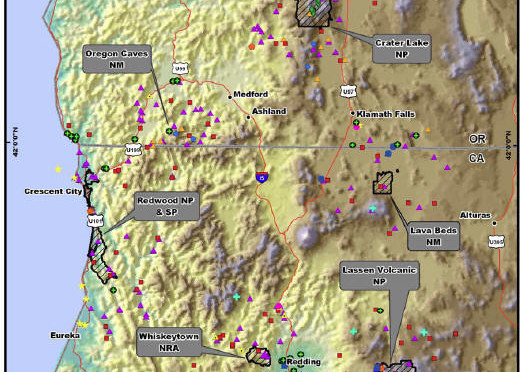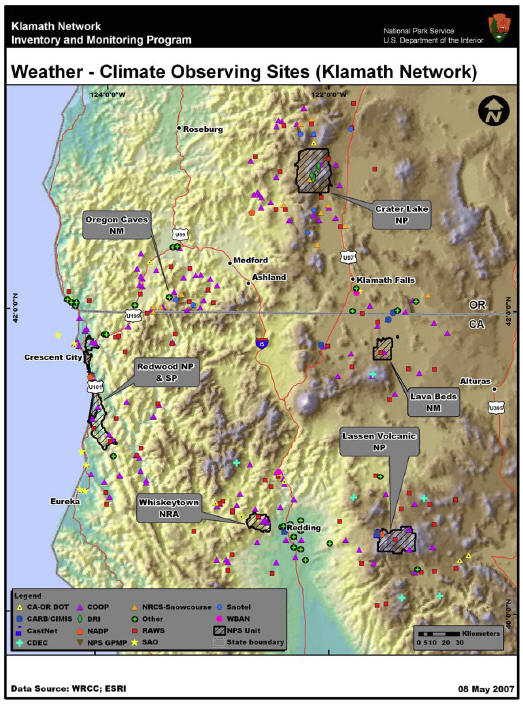Weather and Climate Inventory, Klamath Network, National Park Service, 2007
1.0. Introduction
Weather and climate are key drivers in ecosystem structure and function. Global- and regional scale climate variations will have a tremendous impact on natural systems (Chapin et al. 1996; Schlesinger 1997; Jacobson et al. 2000; Bonan 2002). Long-term patterns in temperature and precipitation provide first-order constraints on potential ecosystem structure and function. Secondary constraints are realized from the intensity and duration of individual weather events and, additionally, from seasonality and inter-annual climate variability. These constraints influence the fundamental properties of ecologic systems, such as soil–water relationships, plant–soil processes, and nutrient cycling, as well as disturbance rates and intensity. These properties, in turn, influence the life-history strategies supported by a climatic regime (Neilson 1987; Rodriguez-Iturbe 2000; Odion et al. 2005).
Given the importance of climate, it is one of 12 basic inventories to be completed by the National Park Service (NPS) Inventory and Monitoring Program (I&M) network (I&M 2006). As primary environmental drivers for the other vital signs, weather and climate patterns present various practical and management consequences and implications for the NPS (Oakley et al. 2003). Most park units observe weather and climate elements as part of their overall mission. The lands under NPS stewardship provide many excellent locations for monitoring climatic conditions.
It is essential that park units within the Klamath Inventory and Monitoring Network (KLMN) have an effective climate-monitoring system in place to track climate changes and to aid in management decisions relating to these changes. The purpose of this report is to determine the current status of weather and climate monitoring within the KLMN (Table 1.1; Figure 1.1). In this report, we provide the following informational elements:
- Overview of broad-scale climatic factors and zones important to KLMN park units.
- Inventory of locations for all weather stations in and near KLMN park units that are relevant to the NPS I&M networks.
- Results of metadata inventory for each station, including weather-monitoring network affiliations, types of recorded measurements, and information about actual measurements (length of record, etc.).
- Initial evaluation of the adequacy of coverage for existing weather stations and recommendations for improvements in monitoring weather and climate.
Table 1.1. Park units in the Klamath Network.
Acronym Name
CRLA Crater Lake National Park
LABE Lava Beds National Monument
LAVO Lassen Volcanic National Park
ORCA Oregon Caves National Monument
REDW Redwood National and State Parks
WHIS Whiskeytown National Recreation Area
Figure 1.1. Map of the Klamath Network.
The primary questions to be addressed by climate- and weather-monitoring activities in KLMN are as follows (Odion et al. 2005):
- What climate changes are associated with El Niño?
- Are there changes in storm severity?
- How is sea level changing?
- Are ocean temperatures changing?
- Are fog dynamics (amount, inland penetration, etc.) changing?
- What is time and location of snowpack (melting, duration, depth)?
- What are the trends in the frost snow free period?
***previous*** — ***next***



